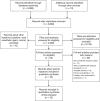Clinical Relevance of Epidural Steroid Injections on Lumbosacral Radicular Syndrome-related Synptoms: Systematic Review and Meta-Analysis
- PMID: 33859113
- PMCID: PMC8162229
- DOI: 10.1097/AJP.0000000000000943
Clinical Relevance of Epidural Steroid Injections on Lumbosacral Radicular Syndrome-related Synptoms: Systematic Review and Meta-Analysis
Abstract
Objectives: Epidural steroid injections (ESIs) can be used to reduce lumbosacral radicular syndrome (LRS) related pain. The clinical relevance of ESIs are currently unknown. This systematic review and meta-analyses aims to assess whether ESIs are clinically relevant for patients with LRS.
Materials and methods: Comprehensive literature searches for randomized controlled trials regarding steroid injections for LRS were conducted in PudMed, EMBASE, CINAHL, and CENTRAL from their inception to September 2018 (December 2019 for PubMed). For each homogenous comparison, the outcomes function, pain intensity and health-related quality of life at different follow-up intervals were pooled separately. The GRADE approach was used to determine the overall certainty of the evidence.
Results: Seventeen studies were included. Two different homogenous comparisons were identified for which the randomized controlled trials could be pooled. In 36 of the 40 analyses no clinically relevant effect was found. The certainty of evidence varied between very low to high. Four analyses found a clinically relevant effect, all on pain intensity and health-related quality of life, but the certainty of the evidence was either low or very low. Two of the 33 subgroup analyses showed a clinically relevant effect. However, according to the GRADE approach the certainty of these findings are low to very low.
Discussion: On the basis of the analyses we conclude there is insufficient evidence that ESIs for patients with LRS are clinically relevant at any follow-up moment. High-quality studies utilizing a predefined clinical success are necessary to identify potential clinically relevant effects of ESIs. Until the results of these studies are available, there is reason to consider whether the current daily practice of ESIs for patients with LRS should continue.
Copyright © 2021 The Author(s). Published by Wolters Kluwer Health, Inc.
Conflict of interest statement
The authors declare no conflict of interest.
Figures
Comment in
-
Systematic Review on Epidural Steroid Injections: Quo Vadis?Clin J Pain. 2021 Nov 1;37(11):863-865. doi: 10.1097/AJP.0000000000000973. Clin J Pain. 2021. PMID: 34419976 No abstract available.
-
Clinical Relevance of Epidural Steroid Injections on Lumbosacral Radicular Syndrome-related Symptoms: Systematic Review and Meta-analysis.Clin J Pain. 2021 Nov 1;37(11):865-866. doi: 10.1097/AJP.0000000000000978. Clin J Pain. 2021. PMID: 34475339 No abstract available.
-
Clinical Relevance of Epidural Steroid Injections on Lumbosacral Radicular Syndrome-related Symptoms: Systematic Review and Meta-Analysis.Clin J Pain. 2021 Nov 1;38(2):149-150. doi: 10.1097/AJP.0000000000000997. Clin J Pain. 2021. PMID: 34723863 No abstract available.
References
-
- International Association for the Study of Pain (IASP). Classification of Chronic Pain, Second Edition (Revised). Available at: https://www.iasp-pain.org/PublicationsNews/Content.aspx?ItemNumber=1673. Accessed March 15, 2019.
-
- Stirling ER, Patel MS, Sell PJ. Sciatica. Br J Hosp Med (Lond). 2016;77:C180–C183. - PubMed
-
- Ropper AH, Zafonte RD. Sciatica. N Engl J Med. 2015;372:1240–1248. - PubMed
Publication types
MeSH terms
Substances
LinkOut - more resources
Full Text Sources
Other Literature Sources


